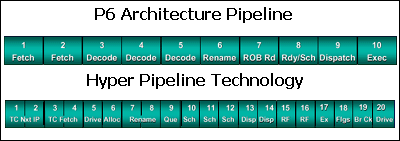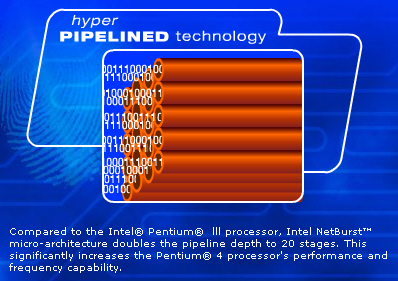 |
|
|
|
In the Forums... |
Posted: December 10, 2000 Written by: Tuan "Solace" Nguyen Hyper Pipelined Technology Intelís strategy is a sure fire one -- obtain the fastest processing speeds possible. Intel has used one method to do so leveraging new architectural improvements in the Pentium 4. But then again, technical improvements arenít going to sell without the hype of GHz power is it? Definitely not. Right now, Intel surely has to be proud of its tremendous success with the Pentium III. After all, that processor saw so many different speeds and sold pretty darn well. So why couldnít Intel just bump up speeds on the Pentium III to 1.5GHz or something? The answer takes a little explaining to do -- you need to have more pipes!  P6 Super Pipeline vs. Pentium 4 Hyper Pipeline Above is a diagram comparing the original execution pipeline of the Pentium Pro. A pipeline is like an assembly line. Chunks of data pass through the pipeline going through stages. In the P6 architecture, there were 10 stages. In Intelís new Hyper Pipeline Technology, there are 20 stages. What does this all have to do with increasing processor speed? Well, to increase processor speed, you have to make it do less per clock cycle, that is, per Hz. You may now be asking, ďWell doesnít a 10-stage pipeline have to do less work than a 20-stage pipeline?Ē The quick answer is no, it doesnít.  Look at all those pipes! What I mean by doing less work is that since the pipeline is longer, it will also take longer for instructions to be processed all the way to the end of the pipeline. With the P6 pipeline, the processor could do, letís say 3 stages per clock cycle. Now letís say with Hyper Pipeline, the Pentium 4 also can do 3 stages per cycle. The Pentium 4 now does 3 out of 20 whereas the P6 did 3 out of 10 -- 50% work per clock cycle. If you design a processor to do less per clock cycle, it is able to reach much higher speeds than processors that do more per clock cycle. This is the reason why Intel released the Pentium 4 at such high speeds. If they were releasing another Pentium III processor, it would likely be only around 1.2GHz. Obviously Intel has the capabilities to create multi GHz processors -- evident with the Pentium 4 -- it's just that the architecture has reached its limits. |
||
|
| |||
|---|---|---|---|